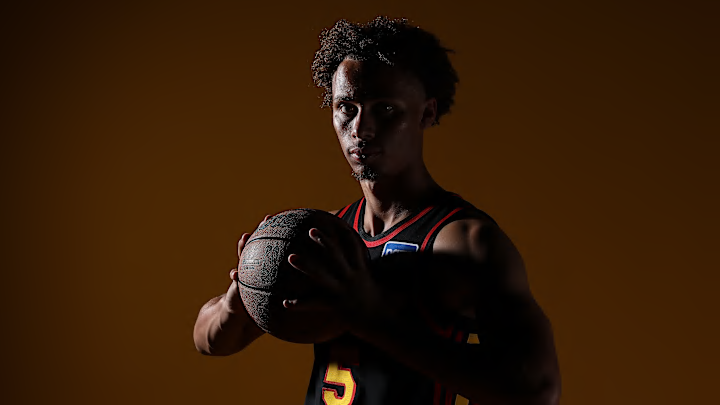Dyson Daniels landed at No. 13 on FanSided's 25-under-25 NBA Player Rankings this season, ranking the best young players in the NBA. Check out the rest of the list here.
It's hard to overstate how much of an outlier Dyson Daniels is.
He averaged 3.0 steals per game last season — a threshold only seven other players in NBA history have ever reached. The last player to hit that mark was Alvin Robertson in 1991. The only other players to even break 2.5 steals per game this century were Chris Paul, Allen Iverson, Gerald Wallace and Metta World Peace, and the most recent of those seasons was more than a decade ago — Paul in 2011-12.
Often, you can trace statistical outliers to obvious variables. Mark Eaton blocked 5.56 shots per game during the 1984-85 season, shattering the previous record set more than a decade before — becoming just the fifth player in history to block at least 4.0 shots per game, and the first and only player to break the 5.0 blocks-per-game barrier. He also 7-foot-4, nearly a foot taller than the average NBA player. He's certainly not the only 7-foot-4 behemoth in NBA history, but his record is a product of both his skill and his absurd height.
In the game in which he scored 100 points, in the season in which he averaged an all-tine record 50.4 points per game, Wilt Chamberlain was eight inches taller and 50 pounds heavier than the average player. He was better than almost everyone, but he was also bigger than everyone.
Steph Curry is the only player in NBA history to make more than 400 3-pointers in a season, and also the only player in NBA history to make 300+ more than once — he's done it six times. But in that record-breaking season, he attempted 886 shots from behind the arc — more than any single team attempted in the first nine seasons after the introduction of the 3-point line in 1979-80. Even in 2000-01, the first full season of this century, his 886 attempts would have been more than four entire teams. Curry is the greatest shooter who ever lived, but his records are a product of both skill and the stylistic evolution of the game.
But Dyson Daniels definitely doesn't fit this pattern. He's 6-foot-8 with a 6-foot-10 wingspan — big for a wing, but certainly not the longest or tallest at his position. He's quick, but not the quickest. His defense benefits from his physical tools, but there are certainly other players working with similar tools. And the dramatic uptick in his thefts can't really be connected to any leaguewide stylistic evolution. And make no mistake, it was a dramatic uptick. He didn't generate more steals just because he played more minutes, his steals per 36 minutes increased by about 40 percent last season.
How do you do that? I'll give you a hint, you don't do it by lifting weights or running with one of those tiny little parachutes strapped to your waist. You don't do it by just trying harder or being blessed with a coach who calls your number when the team needs a stop.
Daniels just got better at things we don't normally think of as malleable — rapid-fire risk-reward analysis, anticipation, timing, spatial awareness. And you can see it in the balance of his numbers. He had 29 more lost ball steals, swiping from a ball-handler, than any other player. He also led the league in steals of bad passes ... by 25. I'm not sure how you do that, to such an absurd degree, but that's where we are.
Subscribe to The Whiteboard, FanSided’s daily email newsletter on everything basketball. If you like The Whiteboard, share it with a friend! If you don’t like The Whiteboard, share it with an enemy.
What if Dyson Daniels isn't done developing?
His steals got the most attention last season, but Daniels also averaged 15.0 points, 6.3 rebounds and 4.7 assists per game. On average, his touches lasted half as long as Trae Young's but, per minute of possession, he averaged more potential assists. That's a little misleading considering how much time Young spends dribbling the ball up court every game. But the point is that Daniels was extremely efficient as a complementary creator. He's also 22 years old.
Imagine what a similar leap in decision-making, anticipation, timing and spatial awareness could do on offense. He so thoroughly controls the game on defense with things that augment his skills and raw athleticism, and he made that leap from good to great in a single season. Making a jump even fractionally as big on offense could make him one of the best two-way players in the league and a legitimate star — the kind of player who could help Trae Young finally get over the hump, or potentially take over for him as a franchise centerpiece in the not too distant future.
Dyson Daniels is an outlier, for reasons that defy convention. And he may be just getting started.
